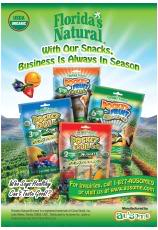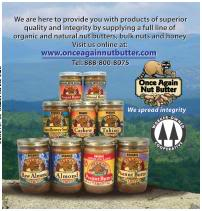It’s hard times in the ol’ USA and people are looking for ways to escape. What better way to do this than to take a journey through some delicious international foods? No, Taco Bell does not count; pizza does not an Italian dinner make; and Asian cuisine offers way more than what comes out of the deliveryman’s car. Thankfully, Americans are starting to catch on to this idea and are enjoying the healthful benefits of foods from Asia, Africa, Central/South America and Europe.
True, America is a wonderful hodgepodge of ethnicities and cultures, but unfortunately, too many choose to remain safely in their own culinary bubble, unaware of all of the amazing treats beyond the borders of their kitchens. And, many of the flavors we’ve become so fond of, such as olive oil, lemongrass and ginger, originate from the far reaches of the globe.
Charlene Lee, director of marketing for San Diego, CA-based Circle Foods, says that consumers are looking for “international or ethnic cuisine that gives them memories of homemade or restaurant-quality experiences.”
 But, says Meera Vasudevan, executive vice president and founder/owner of Old Greenwich, CT-based Preferred Brands International, maker of Tasty Bite, “It isn’t only the ‘authentic’ nature of various cuisines that appeals to consumers; it’s the ability to blend these cuisines in innovative ways.” Truly, innovation is at the heart of our industry and many companies are now are combining flavors and ingredients, and fusing cultures to make for some exciting and healthful products.
But, says Meera Vasudevan, executive vice president and founder/owner of Old Greenwich, CT-based Preferred Brands International, maker of Tasty Bite, “It isn’t only the ‘authentic’ nature of various cuisines that appeals to consumers; it’s the ability to blend these cuisines in innovative ways.” Truly, innovation is at the heart of our industry and many companies are now are combining flavors and ingredients, and fusing cultures to make for some exciting and healthful products.
If Americans want to improve their health through nutrition, there no better place to look than inside health food stores. Sadly, space will only permit a small sampling of the delectable dishes that the world has to offer.
Healthy Across the Map
In our guts (pun intended), we’ve known all along that many international cuisines are very healthy options offering more beneficial nutrients than the typical American diet can. Sourced from all over the world, ingredients and products deliver health benefits right to retail stores here in America. Central to most international dishes are the extra benefits of healthful spices.
 For example, Vasudevan says, “The power of turmeric, a common ingredient in Indian and Asian recipes, is an antioxidant and increasingly used in cancer and Alzheimer’s drugs. Some other good-value ingredients are pepper for respiratory health, ginger for digestive health and for colds, tomatoes for lycopene [for antioxidant protection], garlic and cinnamon for heart health, fenugreek to help lower cholesterol and sugar levels—the list is large. The Tasty Bite product line includes fully cooked, all-natural entrees, rices and legumes, and simmer sauces from India and throughout Asia.
For example, Vasudevan says, “The power of turmeric, a common ingredient in Indian and Asian recipes, is an antioxidant and increasingly used in cancer and Alzheimer’s drugs. Some other good-value ingredients are pepper for respiratory health, ginger for digestive health and for colds, tomatoes for lycopene [for antioxidant protection], garlic and cinnamon for heart health, fenugreek to help lower cholesterol and sugar levels—the list is large. The Tasty Bite product line includes fully cooked, all-natural entrees, rices and legumes, and simmer sauces from India and throughout Asia.
Kathryn Feldenkreis, vice president at Purity Farms, Sedalia, CO, adds that her company’s ghee (clarified butter) product is lactose and casein free, and certified organic. She says it’s only necessary to use half the usual amount of ghee compared to butter, making it a healthier choice for many dishes.
The Mediterranean also has a lot to offer in terms of flavor and nutrition. In addition to heart-healthy olives and olive oil, the scope of Mediterranean foods is expanding in the United States. Carlos Canal, president of Tauton, WA-based Tribe Mediterranean Foods, says, “Hummus and falafel [sales] are continuing to grow. Over the past year, hummus sales grew 20% in the United States alone. Veggie Patch has seen its falafel quadruple in sales in just over a year, gaining greater acceptance in wholesale foods and major grocery chains throughout the United States.”
|
A Spin of the Culinary Globe Here is a sampling of some delectable dishes commonly eaten in various countries: Costa Rica: Casado is a typical Costa Rican meal consisting of rice, beans, plantains, salad, a tortilla, egg and an entree of fish, chicken, beef or pork. Greece: Moussaka is a layered, eggplant-based dish, usually with olive oil, tomatoes, onions and spices. Korea: Kimchi is any one of several varieties of pickled vegetables, usually cabbage. Israel: Falafel is made of spiced chickpeas or fava beans. Malaysia: Nasi lemak is served as a platter of food wrapped in banana leaf, with cucumber slices, small dried anchovies, roasted peanuts, hardboiled egg, and hot spicy sauce called sambal. The rice is soaked in coconut cream and then steamed. Ginger and lemongrass are sometimes added for additional fragrance. Nepal: Dal baht consists of rice (baht) and lentil soup (dal), which can contain tomatoes, onion, chili and ginger along with herbs and spices such as coriander, garam masala and turmeric. Peru: Ceviche is a citrus-marinated seafood dish common to many Latin American countries. The citric acid “cooks” the seafood without any heat. Scotland: Haggis is a dish made of sheep’s “pluck” (heart, liver and lungs), minced with onion, oatmeal, suet and spices, mixed with stock, and traditionally boiled in the animal’s stomach. South Africa: Boboti is spiced minced meat baked with an egg-based topping. Spain: Paella is any one of several varieties of rice mixed with vegetables, legumes, seafood and spices. Taiwan: “Stinky tofu” is a long-fermented type of tofu that gives off a strong odor, but is said to have a mild and favorable taste nonetheless. |
According to Canal, “Our primary ingredient, chickpeas, is heart healthy, low in sugar and high in fiber.” The Veggie Patch line includes an extensive line of meatless products capturing the flavors of the Mediterranean, including the recently launched Falafel Chickpea Balls line. Also, Tribe Hummus is available in all-natural (14 flavors) and organic (five flavors) varieties. Some of these flavors include Cracked Chili Peppers and Roasted Eggplant, also known as babaganoush!
Boasting an impressive national menu, and often incorrectly associated with the Middle Eastern region, Morocco is actually located on the northwestern edge of Africa with coasts on the Mediterranean and the Atlantic. As a result of the country’s location, the cuisine has influences from all surrounding areas, creating an amazing selection of diverse flavors, products and foods.
One of these products is honey, which is generally considered a much healthier option than sugar as a sweetener and as a cooking ingredient. One company, Alili Morocco, based in New York, NY, offers several unique varieties of honey including carob, lavender and jujube. According to www.alilimorocco.com, “The tree that produces the bitter-apple-like jujube fruit also is responsible for Alili’s floral, fragrant and bittersweet Jujube honey” and the carob used is not harvested, but grows wild throughout the landscape. The honeys are produced high within the middle Atlas mountain range in Morocco, giving them their rare flavor.
Central/South American cuisine goes far beyond the rice and beans that are most frequently thought of (even though they are quite delicious!). This region is home to some of the most sought after healthy ingredients in our industry: avocados, chia, the gamut of superfruits, quinoa, cacao and chocolate, sweet potatoes, chili peppers and so on.
In addition to individual healthy ingredients, many companies offer prepared entrees and foods. As an example of Mexican cuisine, says Lee of Circle Foods, “Our top-selling items are made with simple, authentic ingredients and are all natural. With our Nuevo Grille Tamales, we start with corn and convert it to stone-ground masa, and we use high-quality shredded beef and real anjo chiles, all wrapped in traditional corn husks. Our Tortillaland tortillas are all natural with no preservatives and found in the refrigerated section of the grocery store so that consumers can take them home and ‘bake them for the first time.’”
Maintaining Cultural Identity
Although innovation and the fusion of different cuisines can be exciting, some companies realize the potential of remaining true to the cultural identity of their products. Sometimes, unique cultural identifiers (such as production methods or a particular spice) can be lost in translation, which some believe takes away from the true goodness of the food. There are, however, many products that undergo special certifications or protections to ensure that the cultural heritage and distinctive flavors remain intact at the retail level. Retail stores have the opportunity to showcase the amazing qualities found in these products, of which two examples can be seen in products from Italy and Morocco.
 Italy has some interesting standards for maintaining the value of foods from various regions and cultures. According to Giodo Curiat, export manager at Flumeri, Italy-based Baronia Pasta, one of these is Europe’s “Denominazione d’Origine Protetta [DOP],” or Protected Designation of Origin, a prestigious designation that marks foods prepared with traditional methods under strict European guidelines.
Italy has some interesting standards for maintaining the value of foods from various regions and cultures. According to Giodo Curiat, export manager at Flumeri, Italy-based Baronia Pasta, one of these is Europe’s “Denominazione d’Origine Protetta [DOP],” or Protected Designation of Origin, a prestigious designation that marks foods prepared with traditional methods under strict European guidelines.
The salty coastal air and the volcanic ash native to southern Italy makes for a variety of nutritious and delicious flavors of products including olives, pastas and cheeses, each with their own distinctive regional attributes.
Curiat continues, “The landscape and the specific organoleptic properties of a territory offer not just a specific taste to the consumer, but selected health characteristics. The soil itself in Italy leads to an incredible variety of products in the very same category: e.g. extra virgin olive oil, which ranges in infinite nuances from the sweet and light taste in Tuscany, to the pungent Sicilian one, from the bitter/sour Apulian one to the perfectly balanced Abruzzese (just to name the most common ones!).”
Gennaro Testa, expert of the Mozzarella di Bufala Campana DOP, based in San Nicola La Strada, Italy, adds: “A significant trend is towards traditional foods coming from artisanal production, which is linked to the foods preparation using centuries-old methods, linking them directly to their place of origin, as well as keeping historical and cultural backgrounds/traditions in the food-making process.” According to Testa, the Mozzarella di Bufala Campana cheese is made from 100% water buffalo milk, which he says is richer in protein and fat than cow milk. “Mozzarella di Bufala Campana, where ‘Campana’ stands for the Campania region in the center-south of Italy, is the only mozzarella worldwide with DOP certification because of its traditional production methods and its links to historical production and to the southern Italian food culture,” he says.
 Curiat wants consumers to be ready to perceive these nuances in flavor and particular uses for products from different regions. Retailers can address this by having in-store tastings to expand the palates of customers (and staff!). Have an international cuisine night with products from different countries or regions within a particular country so customers can compare and try something new. Perhaps even bring in someone (an expert, or even grandpa from the old country) to lead a discussion and tasting.
Curiat wants consumers to be ready to perceive these nuances in flavor and particular uses for products from different regions. Retailers can address this by having in-store tastings to expand the palates of customers (and staff!). Have an international cuisine night with products from different countries or regions within a particular country so customers can compare and try something new. Perhaps even bring in someone (an expert, or even grandpa from the old country) to lead a discussion and tasting.
Morocco produces an item that is known as no less than “liquid gold.” Argan oil is a product with great health benefits, says Soufiane Lailani, executive director of sales for Alili Morocco, including high levels of vitamin E and essential fatty acids.
As an example of the country’s amazing microclimates (ski in the morning, beach in the afternoon), the Moroccan desert soil provides for the perfect growing conditions for argan trees, producing an oil that is similar to no other. Therefore, the trees are officially protected to preserve the quality of the oil. Alili’s Organic Argan Oil has received numerous awards, has a distinctive, nutty flavor and should be used sparingly as a replacement for truffle or olive oil on salads and grilled meats or fish. According to Lailani, the oil was launched several years ago to a resounding flop in response. But recently, he says, there has been a rise in popular culture “glamour” associated with Morocco (hello, Casablanca, hello, interior design shows) leading to increased interest in its culinary offerings as well and argan oil’s success worldwide.
But, Lailani continues, this glamorization can sometimes take away from the true cultural identity found in traditional foods. As a result, the company prefers to strictly maintain its product line in accordance with Moroccan traditions. For example, the company removed an artichoke product from its line because—even though it was doing well—artichokes are not traditional to Moroccan cuisine.
However, the company did concede to a bit of glamour in its packaging, which makes the products easy to sell by speaking to consumers’ draw to the exotic, says Lailani.
Safety Concerns
Despite this recent magnetism for the exotic, a fascination with food safety still takes precedent over the allure of the unknown. As a result, many companies are becoming more transparent and letting consumers know from where products and ingredients originate—and often by government mandate. An example of this is the Country of Origin Labeling (COOL) regulation for certain foods. For more information, refer to the March issue of WholeFoods, page 8.
 Also, the Codex Alimentarius Commission (CAC) is an intergovernmental body with over 170 members, within the framework of the Joint Food Standards Programe established by the Food and Agriculture Organization of the United Nations and the World Health Organization to promote the safety of international food trade.
Also, the Codex Alimentarius Commission (CAC) is an intergovernmental body with over 170 members, within the framework of the Joint Food Standards Programe established by the Food and Agriculture Organization of the United Nations and the World Health Organization to promote the safety of international food trade.
In addition to these regulatory standards for importing foods, some individual countries go the extra mile to implement their own safety precautions. For example, says Lailani, in Morocco, anything packaged in a jar is put upside-down for 21 days before it is packed and shipped to ensure that nothing leaks, that there is no air penetration and, therefore, no rancidity.
If the upside-down-jar technique doesn’t satisfy one’s requirements for food safety, consumers and retailers can look for certifications by a third-party, such as Quality Assurance International (QAI) and the International Food Standard (IFS). And, many ethnic foods and food products are manufactured right in the United States.
Therefore, there are plenty of ways consumers can feel comfortable trying out new and exciting products from all corners of the earth. And, retailers can cash in on their piece of the international pavlova (pie, New Zealand style). WF
Published in WholeFoods Magazine, October 2009









